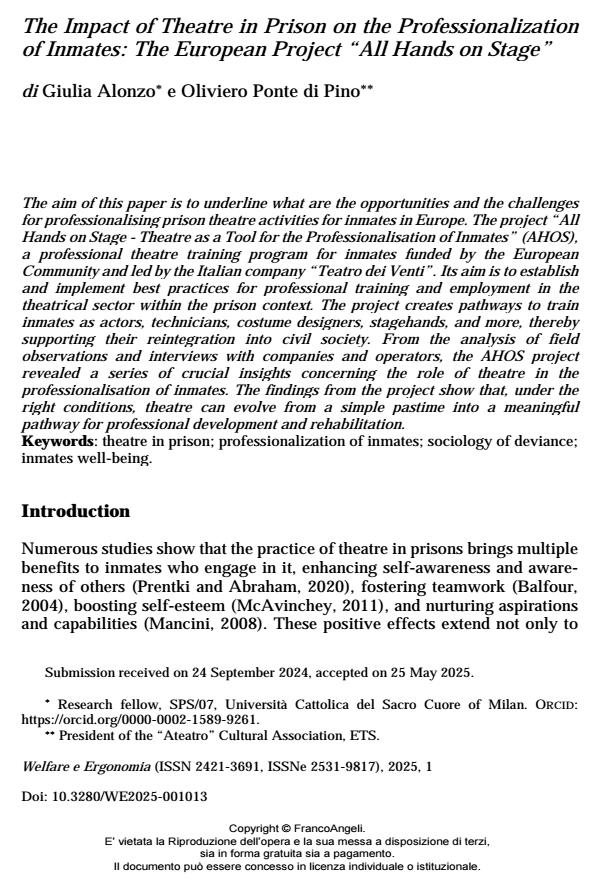The Impact of Theatre in Prison on the Professionalization of Inmates: The European Project “All Hands on Stage”
Titolo Rivista WELFARE E ERGONOMIA
Autori/Curatori Giulia Alonzo, Oliviero Ponte di Pino
Anno di pubblicazione 2025 Fascicolo 2025/1
Lingua Inglese Numero pagine 12 P. 221-232 Dimensione file 87 KB
DOI 10.3280/WE2025-001015
Il DOI è il codice a barre della proprietà intellettuale: per saperne di più
clicca qui
Qui sotto puoi vedere in anteprima la prima pagina di questo articolo.
Se questo articolo ti interessa, lo puoi acquistare (e scaricare in formato pdf) seguendo le facili indicazioni per acquistare il download credit. Acquista Download Credits per scaricare questo Articolo in formato PDF

FrancoAngeli è membro della Publishers International Linking Association, Inc (PILA)associazione indipendente e non profit per facilitare (attraverso i servizi tecnologici implementati da CrossRef.org) l’accesso degli studiosi ai contenuti digitali nelle pubblicazioni professionali e scientifiche
The aim of this paper is to underline what are the opportunities and the challenges for professionalising prison theatre activities for inmates in Europe. The project “All Hands on Stage - Theatre as a Tool for the Professionalisation of Inmates” (AHOS), a professional theatre training program for inmates funded by the European Community and led by the Italian company “Teatro dei Venti”. Its aim is to establish and implement best practices for professional training and employment in the theatrical sector within the prison context. The project creates pathways to train inmates as actors, technicians, costume designers, stagehands, and more, thereby supporting their reintegration into civil society. From the analysis of field observations and interviews with companies and operators, the AHOS project revealed a series of crucial insights concerning the role of theatre in the professionalisation of inmates. The findings from the project show that, under the right conditions, theatre can evolve from a simple pastime into a meaningful pathway for professional development and rehabilitation.
Parole chiave:theatre in prison; professionalization of inmates; sociology of deviance; inmates well-being.
- Mathiesen T. (1965). The Politics of Abolition. Oslo: Universitetsforlaget. (Updated edition: Mathiesen T. (2004). The Politics of Abolition Revisited. London: Routledge).
- Pager D. (2007). Marked: Race, Crime, and Finding Work in an Era of Mass Incarceration. Chicago: University of Chicago Press.
- Pizzetti B. (2023). Carcere e rieducazione. Il contributo della pratica teatrale. Milano: FrancoAngeli.
- Prentki T. and Abraham N. (2020). The Applied Theatre Reader. London: Routledge.
- Aebi M.F., Cocco E. and Hashimoto Y.Z. (2023). Probation and Prisons in Europe 2022: Key Findings of the SPACE report. In: Series UNILCRIM 2023/3. Council of Europe and University of Lausanne.
- Antigone (2023). XIX rapporto sulle condizioni di detenzione. Roma.
- Baim C. (2004). The Geese Theatre Handbook: Drama with Offenders and People at Risk. Waterside Press.
- Balfour M., editor (2004). Theatre in Prison: Theory and Practice. Paperback.
- Bernardi C. (2004). Il teatro sociale. Roma: Carocci editore.
- Bilby C., Caulfield L. and Ridley L. (2013). Re-imagining Futures: Exploring Arts Interventions and the Process of Desistance. University of Central Lancashire.
- Body-Gendrot S., Hough M., Kerezsi K., Lévy R. and Snackenl S. (2014). The Routledge Handbook of European Criminology. Abingdon: Routledge.
- CEPEJ - Evaluation Report (2022). European Judicial Systems. Strasbourg: Council of Europe.
- Cohen M.L. (2011). Theatre, Prison, and Restorative Justice. Springer.
- Elias N. (1939). Über den Prozeß der Zivilisation [The Civilizing Process]. Oxford: Blackwell. (Trad. it.: Il processo di civilizzazione. Bologna: il Mulino, 1988).
- Foucault M. (1975). Surveiller et punir: Naissance de la prison [Discipline and Punish: The Birth of the Prison]. Paris: Gallimard. (Trad. ingl.: Discipline and Punish: The Birth of the Prison. New York: Pantheon Books, 1977).
- Geertz C. (1973). Interpretation of cultures. New York: Basic Books Inc., Publishers.
- Giordano F., Perrini, F. Langer D., Pagano L. and Siciliano G. (2017). L’impatto del teatro in carcere. Misurazione e cambiamento nel sistema penitenziario. Milano: Egea.
- Glaser B.G. and Strauss A.L. (1967). The Discovery of Grounded Theory: Strategies for Qualitative Research. Aldine Publishing.
- Goffman E. (1963). Stigma: Notes on the Management of Spoiled Identity. Englewood Cliffs, NJ: Prentice-Hall.
- Hancock P. and Jewkes Y. (2011). Architectures of Incarceration: The Spatial Pains of Imprisonment. The Howard Journal of Criminal Justice, 50(2): 125-138.
- Hughes J. (2005). Doing the Arts Justice: A Review of Research Literature, Practice, and Theory. London: Arts Council England.
- Jeffers A. (2011). Refugees, Theatre, and Crisis: Performing Global Identities. Palgrave Macmillan.
- McAvinchey C. (2011). Theatre and Prison. London: Palgrave Macmillan.
- Mancini A. (2008). A scene chiuse. Esperienze di teatro in carcere nel mondo. Corazzano: Titivillus.
- Thompson J., editor (2008). Prison Theatre: Perspectives and Practices. Jessica Kingsley Publishers.
Giulia Alonzo, Oliviero Ponte di Pino, The Impact of Theatre in Prison on the Professionalization of Inmates: The European Project “All Hands on Stage” in "WELFARE E ERGONOMIA" 1/2025, pp 221-232, DOI: 10.3280/WE2025-001015